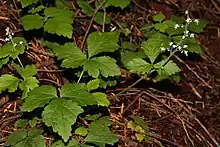Tiarella trifoliata
Tiarella trifoliata, commonly called threeleaf foamflower,[1] laceflower,[2] or sugar-scoop,[2] is a dicot in the family Saxifragaceae.
| Tiarella trifoliata | |
|---|---|
 | |
| Tiarella trifoliata var. trifoliata | |
| Scientific classification | |
| Kingdom: | Plantae |
| Clade: | Tracheophytes |
| Clade: | Angiosperms |
| Clade: | Eudicots |
| Order: | Saxifragales |
| Family: | Saxifragaceae |
| Genus: | Tiarella |
| Species: | T. trifoliata |
| Binomial name | |
| Tiarella trifoliata | |
| Subspecies | |
| |
It is native to the low to moderate elevation moist forests of western North America, from northern California to Montana and western Canada.
Description
Tiarella trifoliata is a perennial herb that grows in the late spring.
The flowers are bell-shaped, white, solitary from an elongate, leafless panicle. The calyx lobes are 1.5–2.5 mm and petals are 3–4 mm. Basal leaves are 15–80 mm long and up to 120 mm wide, trifoliate or palmately 3- to 5-lobed. Cauline leaves are infrequent and much smaller.[1]
Varieties
There are three varieties of T. trifoliata:
- T. trifoliata var. trifoliata, which has leaves that are irregularly lobed, with coarse teeth.
- T. trifoliata var. unifoliata, which has simple leaves.
- T. trifoliata var. laciniata, which is confined in its range from Washington only as far north as Vancouver Island, and has deeply lobed leaves.[3]
References
- "Tiarella trifoliata". WTU Herbarium Image Collection. Burke Museum, University of Washington. Retrieved 2013-04-18.
- "Tiarella trifoliata". Germplasm Resources Information Network (GRIN). Agricultural Research Service (ARS), United States Department of Agriculture (USDA). Retrieved 21 January 2018.
- Pojar, Jim; MacKinnon, Andy. Plants of the Pacific Northwest Coast. Lone Pine Publishing, 1994, p. 168, ISBN 978-1-55105-040-9
External links
 Media related to Tiarella trifoliata at Wikimedia Commons
Media related to Tiarella trifoliata at Wikimedia Commons- Calflora
- Jepson Flora Project (1993): Tiarella trifoliata
This article is issued from Wikipedia. The text is licensed under Creative Commons - Attribution - Sharealike. Additional terms may apply for the media files.